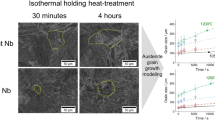Abstract
The present work was carried out on an Al–Cu alloy containing 6.5%Cu, 0.1%Si, 0.4%Mn, and 0.18%Zr (coded HT200). The investigations included hot-tearing tests, microstructural characterization, and tensile properties at room temperature (25 °C). The results were interpreted in terms of application of grain refiner, solidification rate, and phase precipitation. Grain refining using TiBor (0.15%Ti) coupled with high solidification rate (~ 8 °C/s) is proven to be very effective in reducing the alloy hot-tearing sensitivity to be equal to that of A319 alloy with an average grain size of ~ 50–80 µm. In contrast to A319 alloy, the present HT200 alloy required a single step solutionizing treatment (4 h at 520 °C) followed by water quenching to achieve maximum dissolution of the Cu phase. The alloy also exhibited a fast response to aging treatment, resulting in a significant improvement in the alloy tensile strength and quality.














Similar content being viewed by others
References
H.W. Doty, F.H. Samuel, A.M. Nabawy, Cast metal treatment in the molten state to eliminate hot tear defects in low-silicon Al–Cu alloys (GM Global Technology Operations, Inc., Detroit, 2009), p. 16
S. Li, D. Apelian, K. Sadayappan, Hot tearing in cast Al alloys: mechanisms and process controls. Int. J. Metalcast. 6, 51–58 (2012)
A.M. Nabawy, A.M. Samuel, F.H. Samuel, H.W. Doty, Effect of Zr addition and aging treatment on the performance of Al–2%Cu base alloys, in Transactions of the American Foundry Society, Volume 117; 113th Metalcasting Congress, 7–10 April 2009, Las Vegas, Nevada (American Foundry Society, Las Vegas, 2009), pp. 209–223
A.M. Nabawy, A.M. Samuel, F.H. Samuel, H.W. Doty, Zirconium–scandium interactions in Al–2Cu base alloy, in Transactions of the American Foundry Society, Volume 118; 114th Metalcasting Congress, 20–23 March, 2010, CastExpo’10, Orlando, Florida (American Foundry Society, Orlando, 2010), pp. 99–113
J. Borland, Generalized theory of super-solidus cracking in welds and castings. Br. Weld. J. 7(8), 508–512 (1960)
W. Pumphrey, P. Jennings, A consideration of the nature of brittleness at temperature above the solidus in castings and welds in aluminum alloys. J. Inst. Met. 75, 235 (1948)
W. Pellini, Strain theory of hot tearing. Foundry 80, 124–199 (1952)
M. Uludağa, R. Çetin, D. Dispinar, M. Tiryakioğlu, The effects of degassing, grain refinement & Sr-addition on melt quality-hot tear sensitivity relationships in cast A380 aluminum alloy. Eng. Fail. Anal. 90, 90–102 (2018)
H. Ammar, Influence of metallurgical parameters on the mechanical properties and quality indices of Al–Si–Cu–Mg and Al–Si–Mg casting alloys, Ph.D. Thesis, Université du Québec à Chicoutimi, 2010
G.H. Garza-Elizondo, Effect of Ni, Mn, Zr and Sc additions on the performance of Al–Si–Cu–Mg alloys, Ph.D. Thesis, Université du Québec à Chicoutimi, 2016
N. Alexopoulos, Generation of quality maps to support material selection by exploiting the quality indices concept of cast aluminum alloys. Mater. Des. 28, 534–543 (2007)
H. Ammar, A. Samuel, F. Samuel, E. Simielli, G. Sigworth, J. Lin, Influence of aging parameters on the tensile properties and quality index of Al-9 Pct Si-1.8 Pct Cu-0.5 Pct Mg 354-type casting alloys. Metall. Mater. Trans. A 43A, 61–73 (2012)
M. Verbrugge, Mass decompounding and vehicle lightweighting. Mater. Sci. Forum 5, 618–619 (2009)
J. Campbell, T.W. Clyne, Hot tearing in Al–Cu alloys. Int. J. Cast Met. Res. 3, 224–226 (1990)
S. Li, D. Apelian, Hot tearing of aluminum alloys. Int. J. Metalcast. 5, 23–40 (2011)
I.O. Wallinder, X. Zhang, S. Goidanich, N.L. Boze, G. Herting, C. Leygraf, Corrosion and runoff rates of Cu and three Cu-alloys in marine environments with increasing chloride deposition rate. Sci. Total Environ. 472, 681–694 (2014)
F.J. Tavitas-Medrano, S. Valtierra, J.E. Gruzleski, F.H. Samuel, H.W. Doty, A TEM study of the aging behavior of 319 type alloys, in Transactions of the American Foundry Society: 112th Metalcasting Congress, vol. 116, 17–20 May 2008, Atlanta, Georgia (2008), pp. 99–114
F.J. Tavitas-Medrano, A.M.A. Mohamed, J.E. Gruzleski, F.H. Samuel, H.W. Doty, Precipitation-hardening in cast Al–Si–Cu–Mg alloys. J. Mater. Sci. 45, 641–651 (2010)
S.C. Wang, M.J. Starink, Precipitates and intermetallic phases in precipitation hardening Al–Cu–Mg–(Li) based alloys. Int. Mater. Rev. 50, 193–215 (2005)
D.J. Chakrabarti, D.E. Laughlin, Phase relations and precipitation in Al–Mg–Si alloys with Cu additions. Prog. Mater Sci. 49, 389–410 (2004)
M. Drouzy, S. Jacob, M. Richard, Interpretation of tensile results by means of quality index and probable yield strength-application to Al–Si7 Mg foundry alloys-France. Int. Cast Met. J. 5, 43–50 (1980)
A. Dons, G. Heiberg, J. Voje, J. Maeland, J. Loland, A. Prestmo, On the effect of additions of cu and mg on the ductility of Al–Si foundry alloys cast with a cooling rate of approximately 3 K/s. Mater. Sci. Eng. A 413, 561–566 (2005)
H.R. Ammar, C. Moreau, A.M. Samuel, F.H. Samuel, H.W. Doty, Influences of alloying elements, solution treatment time and quenching media on quality indices of 413-type Al–Si casting alloys. Mater. Sci. Eng. A 489, 426–438 (2008)
P. Ratchev, B. Verlinden, P. De Smet, P. Van Houtte, Precipitation hardening of an Al–4.2 wt%Mg–0.6 wt%Cu alloy. Acta Mater. 46, 3523–3533 (1998)
S. Wang, M. Starink, N. Gao, Precipitation hardening in Al–Cu–Mg alloys revisited. Scr. Mater. 54, 287–291 (2006)
P. Ratchev, B. Verlinden, P. De Smet, P. Van Houtte, Effect of cooling rate and predeformation on the precipitation hardening of an Al–4.2 wt%Mg–0.6 wt%Cu alloy. Scr. Mater. 38, 1195–1201 (1998)
Acknowledgements
The authors wish to thank Amal Samuel for enhancing the quality of the images used in this study.
Author information
Authors and Affiliations
Corresponding author
Additional information
Publisher's Note
Springer Nature remains neutral with regard to jurisdictional claims in published maps and institutional affiliations.
Rights and permissions
About this article
Cite this article
Girgis, A., Abdelaziz, M.H., Samuel, A.M. et al. On the Enhancement of the Microstructure and Tensile Properties of an Al–Cu Based Cast Alloy. Metallogr. Microstruct. Anal. 8, 757–769 (2019). https://doi.org/10.1007/s13632-019-00583-8
Received:
Revised:
Accepted:
Published:
Issue Date:
DOI: https://doi.org/10.1007/s13632-019-00583-8




